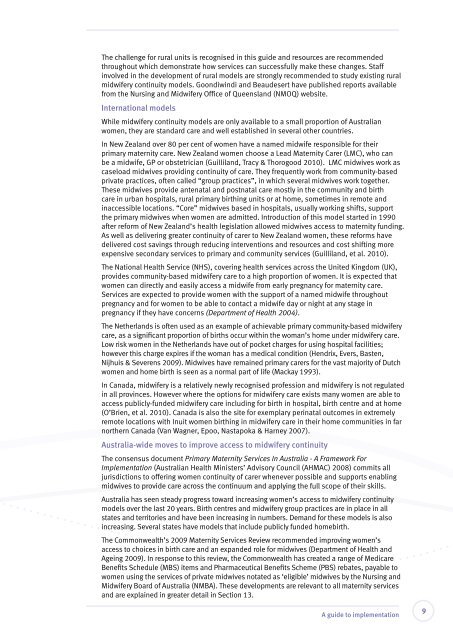Delivering continuity of midwifery care to Queensland women
Delivering continuity of midwifery care to Queensland women
Delivering continuity of midwifery care to Queensland women
You also want an ePaper? Increase the reach of your titles
YUMPU automatically turns print PDFs into web optimized ePapers that Google loves.
The challenge for rural units is recognised in this guide and resources are recommended<br />
throughout which demonstrate how services can successfully make these changes. Staff<br />
involved in the development <strong>of</strong> rural models are strongly recommended <strong>to</strong> study existing rural<br />
<strong>midwifery</strong> <strong>continuity</strong> models. Goondiwindi and Beaudesert have published reports available<br />
from the Nursing and Midwifery Office <strong>of</strong> <strong>Queensland</strong> (NMOQ) website.<br />
International models<br />
While <strong>midwifery</strong> <strong>continuity</strong> models are only available <strong>to</strong> a small proportion <strong>of</strong> Australian<br />
<strong>women</strong>, they are standard <strong>care</strong> and well established in several other countries.<br />
In New Zealand over 80 per cent <strong>of</strong> <strong>women</strong> have a named midwife responsible for their<br />
primary maternity <strong>care</strong>. New Zealand <strong>women</strong> choose a Lead Maternity Carer (LMC), who can<br />
be a midwife, GP or obstetrician (Guilliland, Tracy & Thorogood 2010). LMC midwives work as<br />
caseload midwives providing <strong>continuity</strong> <strong>of</strong> <strong>care</strong>. They frequently work from community-based<br />
private practices, <strong>of</strong>ten called “group practices”, in which several midwives work <strong>to</strong>gether.<br />
These midwives provide antenatal and postnatal <strong>care</strong> mostly in the community and birth<br />
<strong>care</strong> in urban hospitals, rural primary birthing units or at home, sometimes in remote and<br />
inaccessible locations. “Core” midwives based in hospitals, usually working shifts, support<br />
the primary midwives when <strong>women</strong> are admitted. Introduction <strong>of</strong> this model started in 1990<br />
after reform <strong>of</strong> New Zealand’s health legislation allowed midwives access <strong>to</strong> maternity funding.<br />
As well as delivering greater <strong>continuity</strong> <strong>of</strong> <strong>care</strong>r <strong>to</strong> New Zealand <strong>women</strong>, these reforms have<br />
delivered cost savings through reducing interventions and resources and cost shifting more<br />
expensive secondary services <strong>to</strong> primary and community services (Guilliland, et al. 2010).<br />
The National Health Service (NHS), covering health services across the United Kingdom (UK),<br />
provides community-based <strong>midwifery</strong> <strong>care</strong> <strong>to</strong> a high proportion <strong>of</strong> <strong>women</strong>. It is expected that<br />
<strong>women</strong> can directly and easily access a midwife from early pregnancy for maternity <strong>care</strong>.<br />
Services are expected <strong>to</strong> provide <strong>women</strong> with the support <strong>of</strong> a named midwife throughout<br />
pregnancy and for <strong>women</strong> <strong>to</strong> be able <strong>to</strong> contact a midwife day or night at any stage in<br />
pregnancy if they have concerns (Department <strong>of</strong> Health 2004).<br />
The Netherlands is <strong>of</strong>ten used as an example <strong>of</strong> achievable primary community-based <strong>midwifery</strong><br />
<strong>care</strong>, as a significant proportion <strong>of</strong> births occur within the woman’s home under <strong>midwifery</strong> <strong>care</strong>.<br />
Low risk <strong>women</strong> in the Netherlands have out <strong>of</strong> pocket charges for using hospital facilities;<br />
however this charge expires if the woman has a medical condition (Hendrix, Evers, Basten,<br />
Nijhuis & Severens 2009). Midwives have remained primary <strong>care</strong>rs for the vast majority <strong>of</strong> Dutch<br />
<strong>women</strong> and home birth is seen as a normal part <strong>of</strong> life (Mackay 1993).<br />
In Canada, <strong>midwifery</strong> is a relatively newly recognised pr<strong>of</strong>ession and <strong>midwifery</strong> is not regulated<br />
in all provinces. However where the options for <strong>midwifery</strong> <strong>care</strong> exists many <strong>women</strong> are able <strong>to</strong><br />
access publicly-funded <strong>midwifery</strong> <strong>care</strong> including for birth in hospital, birth centre and at home<br />
(O’Brien, et al. 2010). Canada is also the site for exemplary perinatal outcomes in extremely<br />
remote locations with Inuit <strong>women</strong> birthing in <strong>midwifery</strong> <strong>care</strong> in their home communities in far<br />
northern Canada (Van Wagner, Epoo, Nastapoka & Harney 2007).<br />
Australia-wide moves <strong>to</strong> improve access <strong>to</strong> <strong>midwifery</strong> <strong>continuity</strong><br />
The consensus document Primary Maternity Services In Australia - A Framework For<br />
Implementation (Australian Health Ministers’ Advisory Council (AHMAC) 2008) commits all<br />
jurisdictions <strong>to</strong> <strong>of</strong>fering <strong>women</strong> <strong>continuity</strong> <strong>of</strong> <strong>care</strong>r whenever possible and supports enabling<br />
midwives <strong>to</strong> provide <strong>care</strong> across the continuum and applying the full scope <strong>of</strong> their skills.<br />
Australia has seen steady progress <strong>to</strong>ward increasing <strong>women</strong>’s access <strong>to</strong> <strong>midwifery</strong> <strong>continuity</strong><br />
models over the last 20 years. Birth centres and <strong>midwifery</strong> group practices are in place in all<br />
states and terri<strong>to</strong>ries and have been increasing in numbers. Demand for these models is also<br />
increasing. Several states have models that include publicly funded homebirth.<br />
The Commonwealth’s 2009 Maternity Services Review recommended improving <strong>women</strong>’s<br />
access <strong>to</strong> choices in birth <strong>care</strong> and an expanded role for midwives (Department <strong>of</strong> Health and<br />
Ageing 2009). In response <strong>to</strong> this review, the Commonwealth has created a range <strong>of</strong> Medi<strong>care</strong><br />
Benefits Schedule (MBS) items and Pharmaceutical Benefits Scheme (PBS) rebates, payable <strong>to</strong><br />
<strong>women</strong> using the services <strong>of</strong> private midwives notated as ‘eligible’ midwives by the Nursing and<br />
Midwifery Board <strong>of</strong> Australia (NMBA). These developments are relevant <strong>to</strong> all maternity services<br />
and are explained in greater detail in Section 13.<br />
A guide <strong>to</strong> implementation<br />
9
















